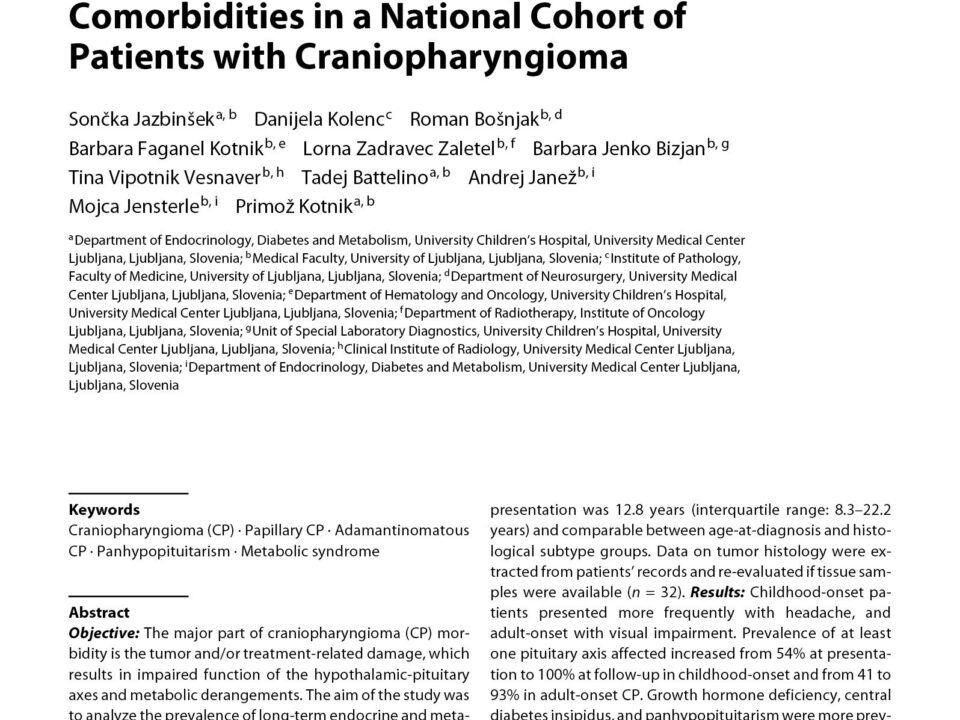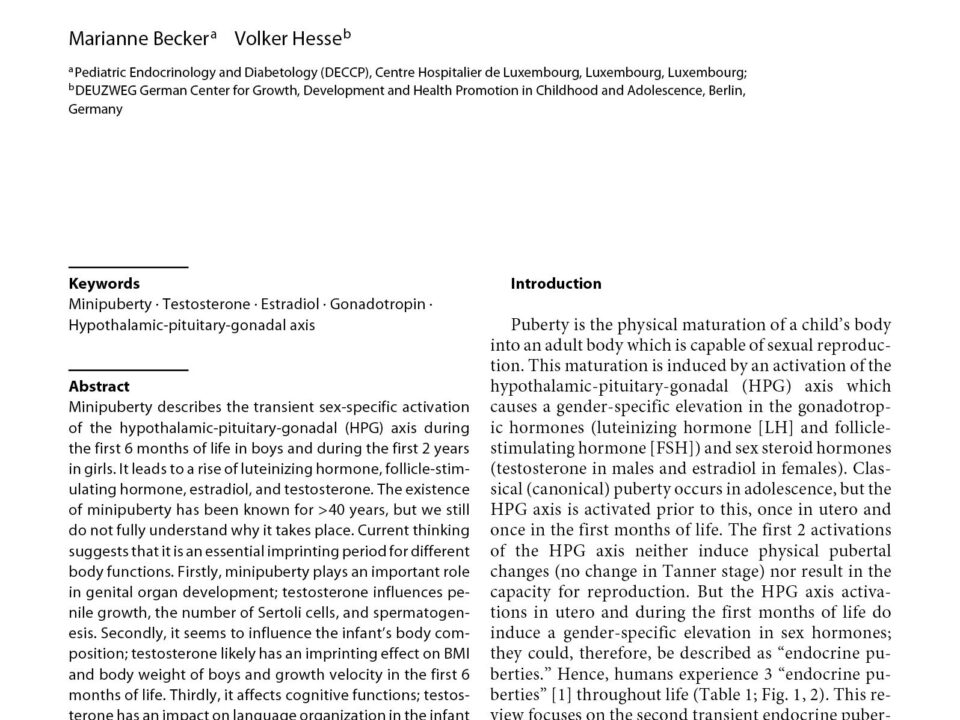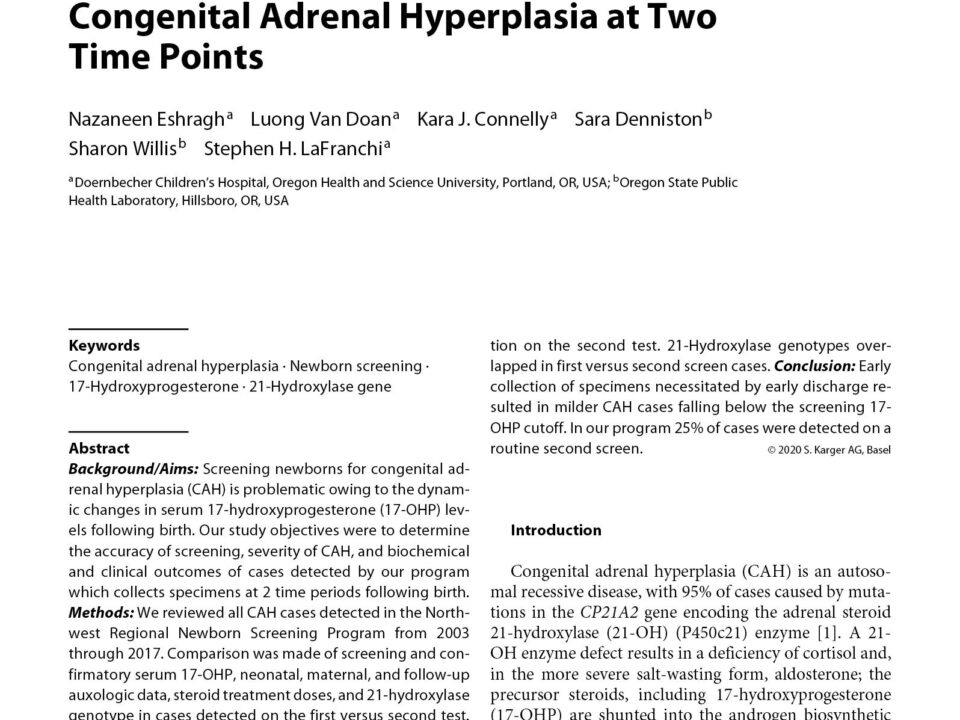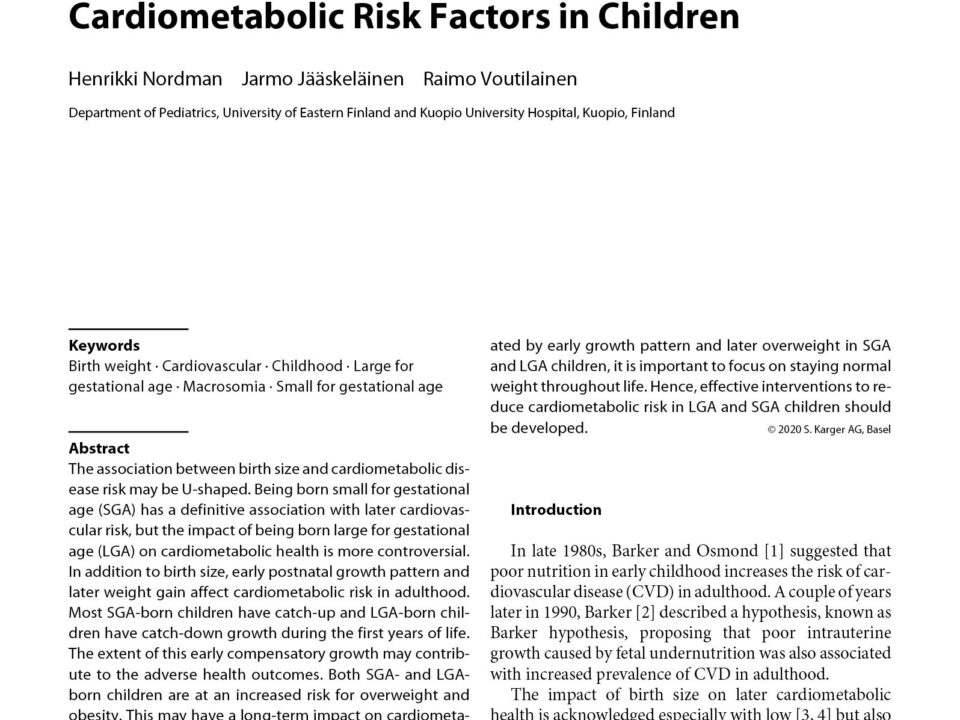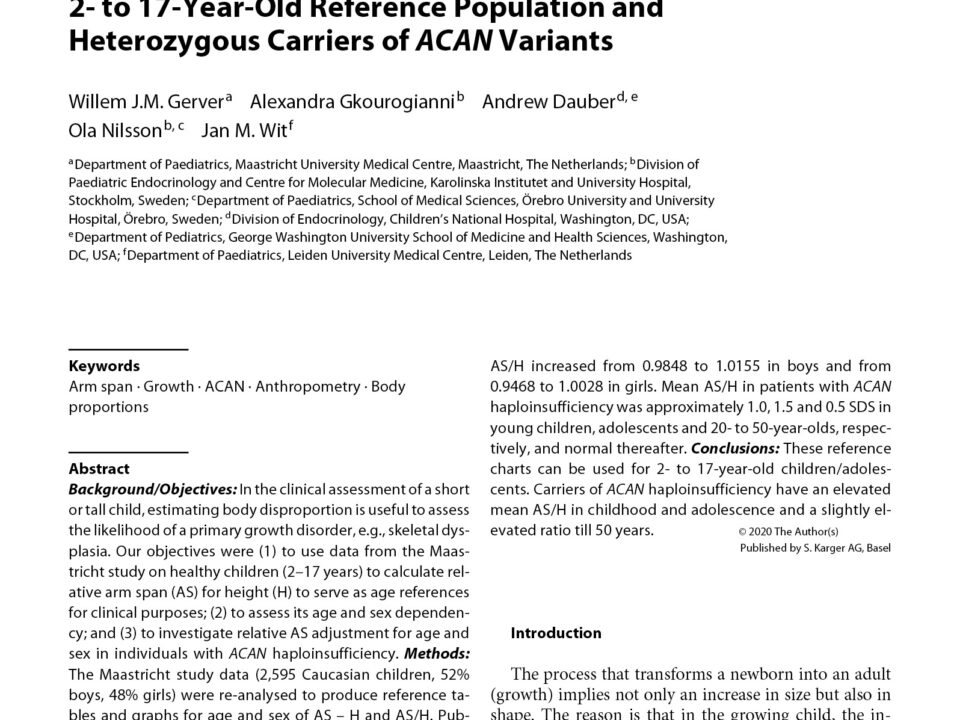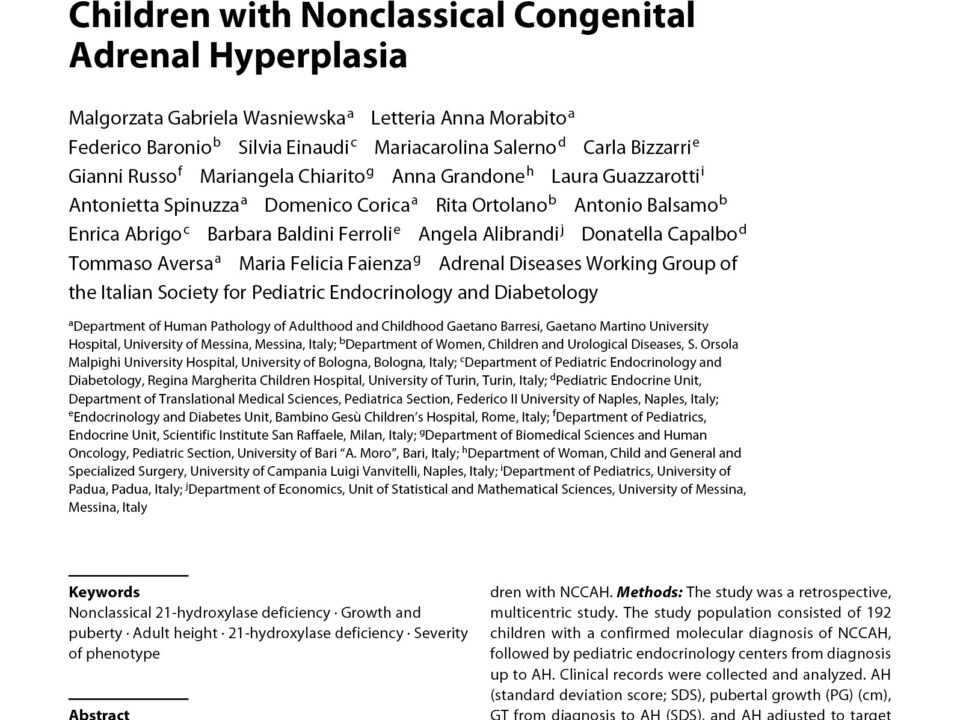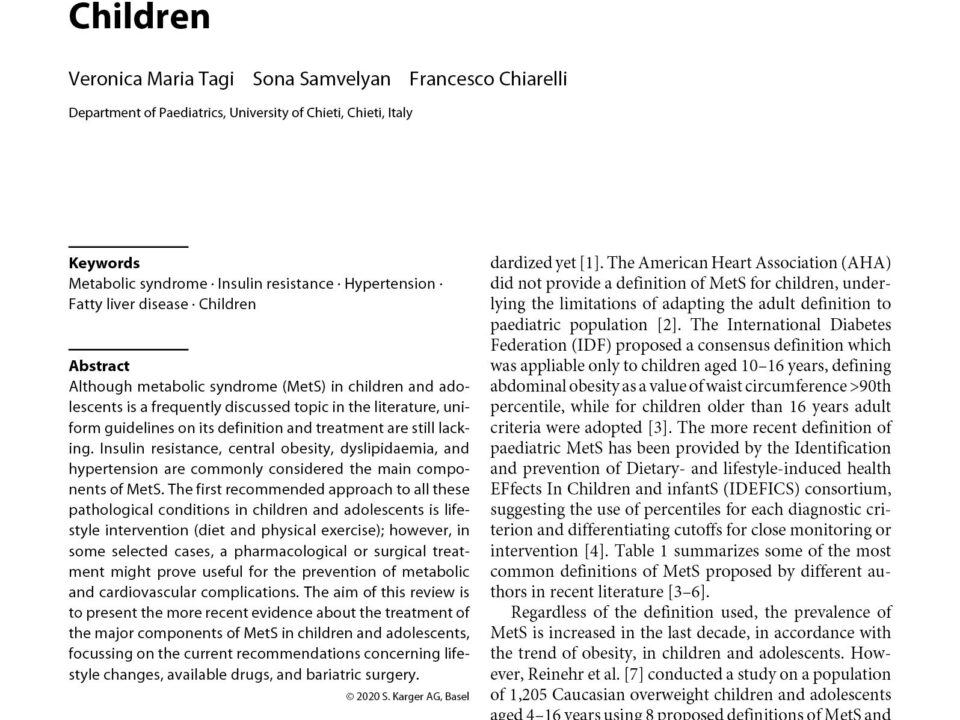December 13, 2022
Objective: The major part of craniopharyngioma (CP) morbidity is the tumor and/or treatment-related damage, which results in impaired function of the hypothalamic-pituitary axes and metabolic derangements. The aim of the study was to analyze the prevalence of long-term endocrine and metabolic comorbidities in a national cohort of CP patients based on the age at diagnosis and histology criteria. Design: A retrospective-prospective longitudinal cohort analysis. Methods: Forty-six patients with CP treated from 1979 onwards (19 with childhood-onset disease) in a single university institution were included in our study. Median follow-up from presentation was 12.8 years (interquartile range: 8.3–22.2 years) and comparable between age-at-diagnosis and histological subtype groups. Data on tumor histology were extracted from patients’ records and re-evaluated if tissue samples were available (n = 32). Results: Childhood-onset patients presented more frequently with headache, and adult-onset with visual impairment. Prevalence of at least one pituitary axis affected increased from 54% at presentation to 100% at follow-up in childhood-onset and from 41 to 93% in adult-onset CP. Growth hormone deficiency, central diabetes insipidus, and panhypopituitarism were more prevalent in childhood-onset adamantinomatous CP (aCP) and least prevalent in adult-onset papillary CP (pCP). At follow-up, metabolic syndrome (MetS) was diagnosed in 80% of childhood-onset and 68% of adult-onset patients (p = 0.411). In the latter group, it tended to be more frequent in the aCP than pCP subtype (80 vs. 50%, p = 0.110). Conclusions: Long-term endocrine and metabolic complications are very frequent in childhood- and adult-onset CP patients of both histological subtypes. The prevalence of MetS was higher compared to the largest cohort previously reported.
December 13, 2022
Minipuberty describes the transient sex-specific activation of the hypothalamic-pituitary-gonadal (HPG) axis during the first 6 months of life in boys and during the first 2 years in girls. It leads to a rise of luteinizing hormone, follicle-stimulating hormone, estradiol, and testosterone. The existence of minipuberty has been known for >40 years, but we still do not fully understand why it takes place. Current thinking suggests that it is an essential imprinting period for different body functions. Firstly, minipuberty plays an important role in genital organ development; testosterone influences penile growth, the number of Sertoli cells, and spermatogenesis. Secondly, it seems to influence the infant’s body composition; testosterone likely has an imprinting effect on BMI and body weight of boys and growth velocity in the first 6 months of life. Thirdly, it affects cognitive functions; testosterone has an impact on language organization in the infant brain and estradiol affects laryngeal sound production and baby babbling. There are inconsistent findings concerning the impact of minipuberty on sex-specific playing behavior. Minipuberty is an interesting field of research, and further studies in this area will teach us more about this exciting period of human development.
December 13, 2022
Background/Aims: Screening newborns for congenital adrenal hyperplasia (CAH) is problematic owing to the dynamic changes in serum 17-hydroxyprogesterone (17-OHP) levels following birth. Our study objectives were to determine the accuracy of screening, severity of CAH, and biochemical and clinical outcomes of cases detected by our program which collects specimens at 2 time periods following birth. Methods: We reviewed all CAH cases detected in the Northwest Regional Newborn Screening Program from 2003 through 2017. Comparison was made of screening and confirmatory serum 17-OHP, neonatal, maternal, and follow-up auxologic data, steroid treatment doses, and 21-hydroxylase genotype in cases detected on the first versus second test. Results: Out of 164 cases of CAH, 25% were detected on the second screen. Infants detected on the second test had a lower screening 17-OHP (147 vs. 294 ng/mL), lower confirmatory serum 17-OHP (7,772 vs. 14,622 ng/dL), and were more likely to have simple virilizing CAH. There were no identifiable neonatal or maternal factors associated with detection on the second test. 21-Hydroxylase genotypes overlapped in first versus second screen cases. Conclusion: Early collection of specimens necessitated by early discharge resulted in milder CAH cases falling below the screening 17-OHP cutoff. In our program 25% of cases were detected on a routine second screen.
December 13, 2022
The association between birth size and cardiometabolic disease risk may be U-shaped. Being born small for gestational age (SGA) has a definitive association with later cardiovascular risk, but the impact of being born large for gestational age (LGA) on cardiometabolic health is more controversial. In addition to birth size, early postnatal growth pattern and later weight gain affect cardiometabolic risk in adulthood. Most SGA-born children have catch-up and LGA-born children have catch-down growth during the first years of life. The extent of this early compensatory growth may contribute to the adverse health outcomes. Both SGA- and LGA-born children are at an increased risk for overweight and obesity. This may have a long-term impact on cardiometabolic health as overweight tends to track to adulthood. Other cardiometabolic risk factors, including alterations in glucose metabolism, dyslipidemia, hypertension, and low-grade inflammation are associated with birth weight. Many of these risk factors are related to overweight or adverse fat distribution. Since later cardiometabolic risk is often mediated by early growth pattern and later overweight in SGA and LGA children, it is important to focus on staying normal weight throughout life. Hence, effective interventions to reduce cardiometabolic risk in LGA and SGA children should be developed.
December 13, 2022
Introduction: Omnitrope® was approved as a biosimilar recombinant human growth hormone (rhGH) in 2006. Objective: The purpose of this work was to evaluate the long-term safety and effectiveness of Omnitrope® in PATRO Children – an ongoing, international, longitudinal, non-interventional study in children who require rhGH treatment. Methods: The study population includes infants, children, and adolescents receiving Omnitrope®. Adverse events (AEs) are monitored for safety and rhGH effectiveness is evaluated by calculation of the height standard deviation score (HSDS), height velocity (HV), and HVSDS using height measurements and country-specific references. Results: As of November 2017, 6,009 patients from 298 centers across 14 countries were enrolled in PATRO Children. Overall, 57.7% of patients had growth hormone deficiency (GHD), 25.8% were born small for gestational age (SGA), and 4.8% had Turner syndrome (TS). In total, 84.1% were rhGH treatment naïve at study entry. The mean duration of Omnitrope® treatment in the study was 36.1 months (range 0–133.7). Overall, 10,360 AEs were reported in 2,750 patients (45.8%). Treatment-related AEs were reported in 396 patients (6.6%; 550 events), and serious AEs (SAE) in 636 patients (10.6%; 1,191 events); 50 SAEs in 37 patients (0.6%) were considered treatment related. Following 5 years of therapy in patients who were rhGH treatment naïve at study entry, improvement from baseline in mean HSDS was +1.85 in GHD, +1.76 in SGA, and +1.0 in TS patients. In total, 912 (17.9%) patients reached adult height (n = 577 GHD, n = 236 SGA, n = 62 TS). Conclusions: This analysis of PATRO Children indicates that biosimilar rhGH is well tolerated and effective in real-world clinical practice.
December 13, 2022
Background/Objectives: In the clinical assessment of a short or tall child, estimating body disproportion is useful to assess the likelihood of a primary growth disorder, e.g., skeletal dysplasia. Our objectives were (1) to use data from the Maastricht study on healthy children (2–17 years) to calculate relative arm span (AS) for height (H) to serve as age references for clinical purposes; (2) to assess its age and sex dependency; and (3) to investigate relative AS adjustment for age and sex in individuals with ACAN haploinsufficiency. Methods: The Maastricht study data (2,595 Caucasian children, 52% boys, 48% girls) were re-analysed to produce reference tables and graphs for age and sex of AS – H and AS/H. Published information on AS/H in Europeans was used as reference data for adults. Relative AS from 33 patients with ACAN haploinsufficiency were plotted against reference data and expressed as standard deviation score (SDS) for age and sex. Results: Mean AS – H from 2 to 17 years increased from –1.2 to +1.5 cm in boys and from –4.8 to +1.6 cm in girls. Mean AS/H increased from 0.9848 to 1.0155 in boys and from 0.9468 to 1.0028 in girls. Mean AS/H in patients with ACAN haploinsufficiency was approximately 1.0, 1.5 and 0.5 SDS in young children, adolescents and 20- to 50-year-olds, respectively, and normal thereafter. Conclusions: These reference charts can be used for 2- to 17-year-old children/adolescents. Carriers of ACAN haploinsufficiency have an elevated mean AS/H in childhood and adolescence and a slightly elevated ratio till 50 years.
December 13, 2022
Background: Children with nonclassical congenital adrenal hyperplasia (NCCAH) often present increased growth velocity secondary to elevation of adrenal androgens that accelerates bone maturation and might compromise adult height (AH). Objective: The aim of the study was to analyze prognostic factors affecting growth trajectory (GT) and AH in children with NCCAH. Methods: The study was a retrospective, multicentric study. The study population consisted of 192 children with a confirmed molecular diagnosis of NCCAH, followed by pediatric endocrinology centers from diagnosis up to AH. Clinical records were collected and analyzed. AH (standard deviation score; SDS), pubertal growth (PG) (cm), GT from diagnosis to AH (SDS), and AH adjusted to target height (TH) (AH-TH SDS) were evaluated as outcome indicators using stepwise linear regression models. Results: The stepwise linear regression analysis showed that AH and AH-TH were significantly related to chronological age (CA) (p = 0.008 and 0.016), bone age (BA)/CA ratio (p = 0.004 and 0.001), height (H) (p < 0.001 for both parameters) at NCCAH diagnosis, and TH (p = 0.013 and <0.001). PG was higher in males than in females (22.59 ± 5.74 vs. 20.72 ± 17.4 cm, p = 0.002), as physiologically observed, and was positively related to height (p = 0.027), negatively to BMI (p = 0.001) and BA/CA ratio (p = 0.001) at NCCAH diagnosis. Gender, genotype, biochemical data, and hydrocortisone treatment did not significantly impair height outcomes of these NCCAH children. Conclusions: The results of this study suggest that AH and GT of NCCAH patients are mainly affected by the severity of phenotype (CA, BA/CA ratio, and H) at the time of diagnosis.
December 13, 2022
Although metabolic syndrome (MetS) in children and adolescents is a frequently discussed topic in the literature, uniform guidelines on its definition and treatment are still lacking. Insulin resistance, central obesity, dyslipidaemia, and hypertension are commonly considered the main components of MetS. The first recommended approach to all these pathological conditions in children and adolescents is lifestyle intervention (diet and physical exercise); however, in some selected cases, a pharmacological or surgical treatment might prove useful for the prevention of metabolic and cardiovascular complications. The aim of this review is to present the more recent evidence about the treatment of the major components of MetS in children and adolescents, focussing on the current recommendations concerning lifestyle changes, available drugs, and bariatric surgery.
December 13, 2022
Patients affected by pseudohypoparathyroidism (PHP) or related disorders are characterized by physical findings that may include brachydactyly, a short stature, a stocky build, early-onset obesity, ectopic ossifications, and neurodevelopmental deficits, as well as hormonal resistance most prominently to parathyroid hormone (PTH). In addition to these alterations, patients may develop other hormonal resistances, leading to overt or subclinical hypothyroidism, hypogonadism and growth hormone (GH) deficiency, impaired growth without measurable evidence for hormonal abnormalities, type 2 diabetes, and skeletal issues with potentially severe limitation of mobility. PHP and related disorders are primarily clinical diagnoses. Given the variability of the clinical, radiological, and biochemical presentation, establishment of the molecular diagnosis is of critical importance for patients. It facilitates management, including prevention of complications, screening and treatment of endocrine deficits, supportive measures, and appropriate genetic counselling. Based on the first international consensus statement for these disorders, this article provides an updated and ready-to-use tool to help physicians and patients outlining relevant interventions and their timing. A life-long coordinated and multidisciplinary approach is recommended, starting as far as possible in early infancy and continuing throughout adulthood with an appropriate and timely transition from pediatric to adult care.
